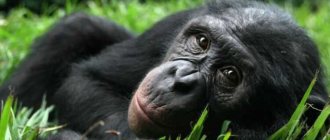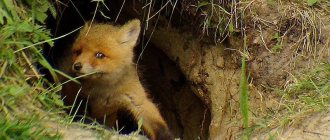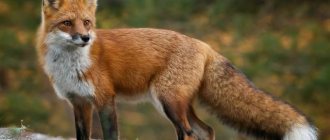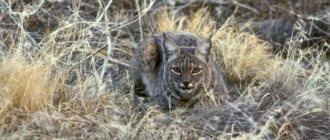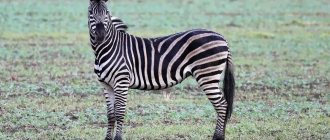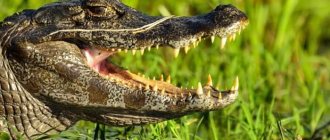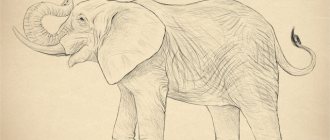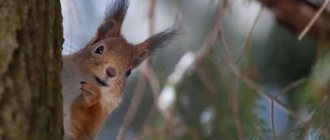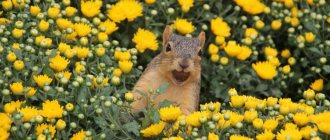Elk is one of the most valuable trophies for any hunter, but since the elk population is not too large, this type of hunting is considered to be not so much a trade as an interesting and exciting form of winter recreation. The thing is that catching this large game is not so easy, and the process itself requires endurance, patience, knowledge of the animal’s habits and marksmanship skills from the hunter.
Since winter is considered the best time for hunting large game, in this article we will look at the main features and types of this fishery, and also provide the necessary information for tracking and shooting elk.
- Gladkostnoe
- How does an animal behave in winter?
Moose hunting in winter
The opening of moose hunting in winter occurs only after stable snow cover appears. Despite the fact that you can shoot elk in the fall, most hunters prefer the cold season.
The fact is that moose shed their antlers in winter, and lead a predominantly sedentary lifestyle, preferring to feed and rest in the thickets along the banks of rivers or other bodies of water. Using this feature, you can hunt elk in almost any permitted way - stealthily, with dogs or in a pen.
Nutrition
The elk's diet consists of all kinds of shrubs, mosses, lichens, mushrooms, tall herbaceous plants (they cannot pinch grass due to their height and short neck), young shoots and leaves of trees (rowan, birch, aspen, bird cherry and other types of shrubs).
Moose hold the branch with their large lips and eat all the foliage. In summer they like to look for food in bodies of water; they can stand with their heads in the water for about a minute and choose various aquatic plants (marigold, water lily, egg capsule, horsetail).
With the arrival of autumn, they move onto the branches and gnaw the bark from the trees. When there is a lot of food, in the summer, the elk eats about 30 kg, but in the winter only 15 kg. A large number of moose harms forests, since one animal eats about 7 tons of vegetation per year. Moose need salt, which they lick off the roads or visit salt licks specially set up for them by rangers.
Hunter Equipment
When planning a winter moose hunt on a snowmobile or on foot, you cannot ignore the recommendations for equipment for the game hunter himself. First of all, you need to choose warm, comfortable clothes that will not make unnecessary rustles or hinder your movements, because the convenience and accuracy of shooting depends on this (Figure 3).
It is advisable to choose warm, multi-layered clothing made from natural fabrics. Synthetic leather cannot breathe and a person gets tired much faster. In addition, it is better to wear several thin sweaters rather than one thick one, since the air layer will retain heat better.
Figure 3. Required equipment
Considering the weak visual acuity of the moose, take care of a camouflage robe. If you sit motionless in it, the moose is unlikely to notice you and will come to a fairly close distance. It is also necessary to protect your hands and feet from the cold. Shoes should be warm and comfortable, since hunting game often requires a lot of walking through the forest. To make your task easier, you can additionally include skis in your equipment. It is advisable to wear thin woolen gloves on your hands, but in severe frosts they can be supplemented with mittens with a slot for the index finger.
Anatomical features of the animal elk
The elk differs from other representatives of the deer family not only in its appearance, but also in a number of anatomical and physiological features:
- A distinctive feature of this animal is its large body with a short torso. There is a strongly developed chest, protruding forward.
- Under the animal's throat, you can see a soft outgrowth of skin, which is called an earring.
- Young representatives have pointed hooves, which serve to protect against attacking enemies. Interesting fact: with one blow of such a hoof, an elk can pierce the skull of an attacking wolf or bear.
- Also noteworthy are the powerful withers and large head, strongly protruding forward.
- The legs are long with a developed musculoskeletal system.
- The elk antlers deserve special attention. Only males have horns, and every spring the antlers are replaced with a new pair. Depending on the age of the male and the stage of development of the spade (the main part of the horns), antlers may have a soft, easily vulnerable surface. Such horns are easily susceptible to insect attacks and mechanical injuries. But as the tissue grows, it undergoes a process of keratinization and acquires the proper rigidity and strength.
Elk meat is considered dietary due to its low content of saturated animal fats; it has a pleasant taste and is perfectly digestible. Such properties are determined due to the special diet of moose in nature.
Rules for choosing weapons
Since elk is one of the largest forest inhabitants, the choice of weapons for hunting it must be approached as responsibly as possible. For such fishing, all types of guns are used - smooth-bore, rifled or combined. The difference between them lies only in the firing range in meters (Figure 4).
However, when choosing a firearm for elk, it is recommended to be guided not so much by personal preferences as by indicators of shooting accuracy. In order to kill your prey with the first shot, it is advisable to select a gun with an accuracy of fire from 3-6 cm to 100 meters.
Gladkostnoe
Russian legislation provides for the use of 12-16 caliber smoothbore shotguns as hunting weapons. As a rule, such models are equipped with one or two folding or non-folding barrels. At the same time, most experienced hunters prefer to use a double-barreled shotgun, since such a gun is practical and reliable.
Figure 4. Required weapons and ammunition
The popularity of double-barreled guns is primarily explained by the fact that they allow you to fire two shots in a row without reloading. However, when choosing a smooth-bore weapon, give preference to light models, since elk hunting involves a lot of walking.
Rifled
Choosing a suitable rifled weapon will not be difficult, because it includes the most common rifles, rifles and carbines. Many experienced fishermen prefer just such guns, because they are distinguished by higher lethal qualities.
The most popular models of this type are “Berkut”, “Vepr”, “Saiga” and “Winchester”.
Combined
A combination firearm is considered universal and is suitable for both experienced and novice hunters.
To charge it, two types of bullets are used. The lower one is loaded with semi-jacketed ammunition, which is distinguished by its high destructive power and firing range. For the lower barrel, non-ricochet bullets are used, which are suitable for close-range shooting from a distance of no more than 60 meters. As a rule, it is the lower barrel that is used for shooting at elk located in the thickets.
Elk bed in the summer season
In the summer season, mosquitoes cause great inconvenience to moose. Trying to evade them, animals lie down in open areas that are blown by the wind. Among them are river banks, shallows and spacious clearings. In high areas, for example in the mountains, elk tend to climb beyond the boundaries of forest areas. In the lowlands, animals rest right in the water. In some cases, especially during periods of mass distribution of bloodsuckers, an elk can go into the river up to its ears.
In small rivers the animal lies in the water on one of its sides. In areas that are densely populated, elk can hide from midges in wet alder forests, dense wilds or young spruce forests. With the onset of summer, animals begin to feed only at dusk, because it becomes cooler and there are no gadflies.
We select cartridges
Special attention should be paid to choosing suitable ammunition. Since the elk is considered a tough animal to take a wound, 12 and 16 caliber bullets are used to kill it (for smoothbore weapons. With such a gun, the optimal distance for an effective shot will be about 50 meters, but some bullets can accurately hit the target from a distance of 80 meters .
If you use a rifled weapon, you should be even more careful when choosing ammunition. If the cartridges are chosen incorrectly, even the highest quality gun will not bring the desired trophy. The best option is a 9.3*62 caliber shotgun with a short barrel. Such weapons have relatively low recoil, but high destructive power.
Ammunition should also be selected taking into account the terrain. If you know that you will have to shoot from a long distance, about 150-200 meters, it is better to use the 9.3*54R caliber, however, you should keep in mind that this caliber will not be effective when hitting close targets.
Interesting facts about moose
Some interesting facts about elk that will draw attention to these amazing representatives of the animal world:
- Today, in many countries you can find real moose farms, where the animals are not afraid of poachers.
- Moose milk and meat are consumed quite often. Both milk and meat are classified as dietary (medicinal) foods.
- All moose (females and males equally) have well-developed senses of smell and hearing. But eagles see poorly.
- Animals primarily use their front legs and broad chest as defense against natural enemies.
Despite their extremely calm lifestyle, moose run well at high speed (up to 55 km/h) and are also good swimmers.
How to shoot a moose correctly
As with hunting any large game, hunting an elk involves targeted shooting, and you need to try to hit a certain part of the animal’s body. You need to aim very carefully and according to all the rules, since an unsuccessful shot can not only scare away the game, but also cause the presence of a wounded animal, which will have to be found and finished off (Figure 5).
To accurately get the trophy, you need to know where to shoot. The following are considered killing areas for elk:
- The area under the shoulder blade, since this is where the vital organs are located - the heart and lungs.
- When hit in the neck, the main blood vessel, the aorta, is damaged, and the animal quickly dies.
- A well-aimed shot to the head also results in the instant death of an elk, as its brain is damaged in the process. Similarly, you can shoot at the elk’s spine.
Despite the fact that there are quite a lot of killing places for moose, experienced hunters advise aiming specifically under the shoulder blade. The fact is that it is not always possible to make an accurate shot in the head, and the thick layer of fur on the animal’s back will prevent it from breaking the spine. In addition, it is possible to pierce the skull bones or ridge only with a powerful weapon and a short distance. By shooting under the shoulder blade, you are guaranteed to kill your prey, even if the heart is not hit. The injury will be so serious that the animal simply will not be able to go far.
Figure 5. Killing places of elk
If you still failed to make a fatal shot, and the wounded man escaped, it makes sense to examine the traces of blood in the snow and determine whether it is worth pursuing the prey. According to unspoken rules, the wounded animal must be found and finished off, but if the wound was minor, the elk can go very far and it will be impossible to find him.
By carefully examining the bloody tracks in the snow, you can decide whether to go after the elk:
- If traces of scarlet blood with bubbles are visible, it means the bullet hit the animal’s lungs and it will not be able to go far.
- Traces of dark blood with clots indicate a serious wound, regardless of which part of the body the bullet hit.
- If blood trails are visible on both sides of the hoof prints, this means that the bullet went right through and you will not be able to catch the animal.
- It makes no sense to pursue game even if the blood trail is too thin or quickly interrupted. This indicates that the elk was slightly injured.
In addition to traces of blood, carefully examine other marks on the snow. For example, if you notice tufts of long fur, this means that the animal was wounded in the upper body. If the hair is light and short, you shot the elk in the leg and he will be able to escape.
In any case, if you have the ability to quickly move through a snowy forest, it is better to follow the wounded animal's trail for a while. In most cases, a wounded elk should lie down to rest and cool the wound. If you don’t waste time and immediately give chase, you will be able to finish off the animal.
Kinds
Elk is the name of the genus representing the deer family. Not so long ago it was believed that it consists of a single species of the same name. But significant difficulties arose with intraspecific taxonomy.
It turned out to be difficult to accurately determine and classify the number of species and subspecies. And on this matter, zoologists are divided in opinion. Modern genetics has helped provide answers to confusing questions. According to this source, the moose genus should be divided into not one, but two species.
Let's take a closer look at them.
1. Eastern elk . This species is in turn divided into two subspecies: European and Caucasian. Their representatives are very tall animals, sometimes reaching a weight of up to 650 kg. The antlers of such moose are striking with a span of 135 centimeters or more.
Their hair is dark in color. The back is marked with a black stripe. The end of the muzzle and the fur on the legs are somewhat lighter. The belly and back of the legs of these mammals, as well as their upper lip, are almost white.
2. Western elk . Sometimes this species is called American in another way, but it is also correct to call it East Siberian, because representatives of the elk kingdom of these two, at first glance, distant regions of the planet are genetically similar to each other.
This species is divided into Eastern Canadian and Ussuri subspecies. Such animals are slightly smaller in size than their previously described relatives. And the span of their horns is about a meter. True, there are exceptions, because in Canada and the Far East you can find very large specimens, weighing up to 700 kg.
The coloring of such moose is very diverse. Their neck and upper body are usually rusty-brown or grayish. The legs above, as well as the sides below, are most often black.
Features of hunting in winter
Many hunters prefer to hunt moose in winter for several reasons. Firstly, the tracks of the animal are clearly visible on fresh snow, and an attentive hunter will be able to easily find a feeding or bedding area.
Secondly, with the onset of cold weather, elk become less mobile, so it will be easier to track and shoot them. Despite the apparent ease of such fishing, its success will depend on both your shooting skills and your knowledge of the habits of the animal.
How does an animal behave in winter?
The main winter feature of these animals is that with the arrival of cold weather, the males shed their antlers. This is typical only for males, since females are generally devoid of horns. In addition, with the onset of cold weather, animals migrate from deciduous forests to coniferous ones and arrange a place for resting (bedding) and feeding.
Moose go out in search of food before dawn and after sunset, and the rest of the time they lie down, digesting food.
Note: The colder it gets, the less mobile moose become. For example, during a sharp cold snap, their movement from a resting place to a feeding place can be reduced from 3-5 kilometers to several hundred meters.
The moose feeding area is usually well protected so that wolves or hunters cannot get close to it. You should also take into account another winter feature of moose: during the cold season, most females are pregnant with one or even several cubs. Therefore, it is better to shoot males, so as not to reduce the number of elk. For a similar reason, it is prohibited to put nooses on elk, since this type of hunting is considered poaching.
Tracking an elk
Moose hunting begins with tracking the animal's tracks. Fortunately, in the snow it is quite easy to determine whether an animal is in a certain area. First of all, calm and rutting traces of the animal will be visible on the surface, as well as its ureters (stumps, trees and other places that the animal marks). The presence of moose in the area is also indicated by excrement or visible feeding areas.
Figure 6. Tracking an animal by its tracks
It is better to track an elk on fresh snow, since fresh tracks of game will be clearly visible on it (Figure 6).
Note: On average, the length of the hoof without side toes is 15 cm with a stride length of 70-90 cm, but if the animal was trotting, the gaps between prints can be up to 150 cm.
The easiest way to determine the direction of movement of an elk is by looking at a fresh track. It is this method that is most often used to track an animal when hunting in a pen.
To find out exactly where the animal is going, use these tips:
- The mounds of snow along the edge of the print are called drifts. It is by this that the direction of movement of the animal is determined.
- You need to move strictly in the direction where the drag is pointing.
- On the opposite side of the trace there is a wire. It is flatter than a drag.
- It is also necessary to determine the nature of the trace. If furrows are clearly visible between the prints, this means that the elk ran quickly, left a rutting trail, and it is absolutely pointless to pursue such an animal. It may be several tens of kilometers away from you.
Since it is better to hunt males in winter, it is important to learn to distinguish the trail of a female from a male. Unfortunately, this is difficult for a novice hunter to do, but in practice it is possible to distinguish the tracks of a female and a male by their ureters. In females they are located between the footprints, and in males they are located in front of them. In addition, excrement differs among individuals of different sexes. In moose they are more rounded and stuck together, while in moose they are elongated and somewhat resemble acorns in appearance.
The location of the animal can also be determined by the place of feeding: this will be indicated by broken branches and tree trunks, stripped of bark at a height of one and a half to two meters.
Rules of approach
If you manage to find a suitable game trail, you can start hunting elk in the winter with an approach. At the same time, approaching the animal must also follow certain rules. Driven hunting in this case may not be effective enough, since a large number of hunters will simply trample the trail or scare away the animal (Figure 7).
Note: When starting to trail, be sure to move not along the trail itself, but to the side of it, keeping to the leeward side.
When following the trail, you need to be extremely careful and behave as quietly as possible. Load your gun in advance, as any bush or boulder, upon close inspection, may turn out to be a moose lying down. If, when approaching, you accidentally startle the animal, do not try to catch up with it. You need to let the animal calm down and then the elk will either start feeding again or lie down to rest and you can overtake him without any problems.
Figure 7. You need to approach the animal very quietly and carefully
In addition, when approaching an elk, carefully inspect the surroundings: if you notice a bedding area, it is quite possible that you will soon find a feeding area. Conversely, broken branches and the absence of bark on the trees indicate that somewhere nearby there is a resting place of the elk.
Hunters with smooth-bore guns should be especially attentive and careful, since the optimal shooting distance for such weapons is only 50 meters, which means they will have to approach the elk very quietly and carefully.
Hunting for elk by stealth
The name of this hunting method does not directly indicate the behavior of the hunter. In other words, the fisherman knows exactly where the animal is feeding or resting and begins to creep up to it at the optimal distance for a shot. The main task is to maintain complete silence and inconspicuousness, so it is better to move around on skis. It is also advisable to have a 12-gauge shotgun in your arsenal in order to kill the game with the first shot (Figure 8).
Note: It is best to stalk hunt on a sunny and frosty day with a light wind, which will muffle sounds and help you get closer to the elk more quietly.
Figure 8. The success of hunting depends on your skills in silent movement.
You need to go out hunting at night in order to get to the animals’ resting place after they have finished feeding. As soon as it gets lighter and signs of the presence of game become obvious, you can begin to sneak up on the prey, moving against the wind so that the animal does not smell the human scent.
Hunting with a husky
One of the most popular methods of moose hunting is considered to be hunting game with huskies or other dogs. But the best are still considered to be animal huskies, which specialize specifically in large game (Figure 9).
The main skill that dogs must have is to hold the elk in place until the hunter arrives. At the same time, your helpers must be fearless and well trained, so that at the most crucial moment the dog is not afraid of a large moose. In general, 2-3 experienced dogs are enough to keep the elk in place, but you still cannot hesitate to shoot so that the elk does not injure your helpers.
Figure 9. Likes will help hold the animal until the hunter arrives
There are two main types of hunting with dogs: on a leash and on the trail. Since each of them has its own characteristics, we will look at these methods in more detail.
On the trail
If you do not have sufficient skills in reading elk tracks, but have good huskies, you can very well use them for trail hunting. To do this, you just need to find a moose trail and let the dogs follow it. They will quickly find game and notify the owner about it with loud barking.
After that, all you have to do is approach the optimal distance and shoot at the game. It should be borne in mind that hounds of dogs are not used for trail hunting and for elk hunting in general. If such an individual smells such large game even once, other animals will simply cease to interest it.
On a leash
More experienced and well-trained dogs can also be used for hunting on a leash. It is important that the individual is trained specifically for elk. Then the smells of other animals will not distract her from searching for game.
This type of hunting with dogs is carried out in complete silence. First you need to find the trail of the animal and let the dog follow it. She will lead the hunter to the animal’s feeding or resting place without barking. You can determine that a husky has smelled a moose by the strong tension on the leash. After this, you need to approach the animal as discreetly as possible and make an accurate shot in one of the killing zones.
Who spends the winter like this?
In the kitchen there was a flat basket on a stool, a saucepan on the stove, and a large white dish on the table. There were crayfish in the basket, there was boiling water with dill and salt in the pan, but there was nothing on the dish.
The hostess came in and began: once, she lowered her hand into the basket and grabbed the crayfish across the back; two - I threw the crayfish into the pan, waited until it was cooked, and - three - I transferred the crayfish from the pan to a dish with a spoon. And it went, and it went!
Once - a black crayfish, grabbed across the back, angrily moved its mustache, opened its claws and flicked its tail; two - the crayfish was dipped in boiling water, stopped moving and turned red; three - the red crayfish lay on the dish, lay motionless, and steam came from it.
One-two-three, one-two-three - there were fewer and fewer black crayfish left in the basket, the boiling water in the pan was boiling and gurgling, and a mountain of red crayfish was growing on a white dish.
And now there is one last crayfish left in the basket.
Once - and the mistress grabbed him across the back.
At this time they shouted something to her from the dining room.
- I’m bringing it, I’m bringing it, - the last one! - the hostess answered - I got confused: two - I threw the black crayfish onto the dish, waited a little, picked up the red crayfish from the dish with a spoon and three - I dropped it into boiling water.
The red crayfish didn’t care where to lie - in a hot pan or on a cool dish. The black crayfish didn’t want to go into the pan at all; He didn’t want to lie on the platter either. More than anything in the world, he wanted to go where the crayfish spend the winter. And - without hesitation for a long time - he began his journey: backwards, backwards to the backyard.
He came across a mountain of motionless red crayfish and hid under them.
The hostess decorated the dish with dill and served it on the table.
The white dish with red crayfish and green dill was beautiful. The crayfish were delicious. The guests were hungry. The hostess was busy. And no one noticed how the black crayfish rolled from the dish onto the table and crawled backwards, backwards under the plate, backwards, backwards to the very edge of the table.
And under the table there was a kitten sitting and waiting to see if he would get something from the master’s table.
Suddenly - bang! — someone black and mustachioed cracked in front of him.
The kitten didn’t know it was a cancer, he thought it was a big black cockroach, and pushed it with his nose.
Cancer backed away.
The kitten touched him with his paw.
The cancer raised its claw.
The kitten decided that it was not worth dealing with him, turned around and smeared him with its tail.
And grab the cancer! - and pinched the tip of his tail with his claw.
What happened to the kitten? Meow! - He jumped onto the chair. Meow! - from chair to table. Meow! - from the table to the windowsill. Meow! - and jumped out into the yard.
- Hold it, hold it, you madman! - the guests shouted.
But the kitten rushed like a whirlwind across the yard, flew up onto the fence, and rushed across the garden. There was a pond in the garden, and the kitten would probably have fallen into the water if the cancer had not unclenched its claws and let go of its tail.
The kitten turned back and galloped home.
The pond was small, all overgrown with grass and mud. Lazy tailed newts, crucian carp, and snails lived in it. Their life was boring - everything was always the same. Newts swam up and down, crucian carp swam back and forth, snails crawled on the grass - one day it crawls up, the next day it goes down.
Suddenly the water splashed, and someone’s black body, blowing bubbles, sank to the bottom.
Now everyone gathered to look at him - newts swam, crucians came running, snails crawled down.
And it’s true, there was something to look at: the black one was covered in armor - from the tips of the mustache to the tip of the tail. Smooth armor covered his chest and back. From under the hard visor, two motionless eyes protruded on thin stalks. Long straight mustaches stuck out forward like peaks. Four pairs of thin legs were like forks, two claws were like two toothy mouths.
None of the pond residents had ever seen a crayfish in their lives, and everyone climbed closer to it out of curiosity. The cancer moved - everyone got scared and moved away. The crayfish raised its front leg, grabbed its eye with a fork, pulled out the stem and started cleaning it.
It was so surprising that everyone again climbed onto the crayfish, and one crucian carp even stumbled upon his mustache.
Raz! - the crayfish grabbed him with its claw, and the stupid crucian carp flew in half.
The fish and crucian carp became alarmed and ran away in all directions. And the hungry cancer calmly began to eat.
The cancer in the pond healed well. All day long he rested in the mud. He wandered around at night, felt the bottom and grass with his mustache, and grabbed slow-moving snails with his claws.
The newts and crucians were now afraid of him and would not let him get close to them. Yes, snails were enough for him: he ate them along with the houses, and his shell only became stronger from such food.
But the water in the pond was rotten and musty. And he was still drawn to where the crayfish spend the winter.
One evening it started to rain. It rained all night, and by morning the water in the pond rose and overflowed its banks. The stream picked up the crayfish and carried it out of the pond, poked it into some stump, picked it up again and threw it into a ditch.
The cancer was delighted, straightened its wide tail, clapped it in the water and swam backwards and backwards, as if crawling.
But the rain stopped, the ditch became shallow - it became uncomfortable to swim. The cancer has crawled.
He crawled for a long time. He rested during the day and set off again at night. The first ditch turned into the second, the second into the third, the third into the fourth, and he still backed away, crawled, crawled - and still could not crawl anywhere, get out of a hundred ditches.
On the tenth day of the journey, he climbed, hungry, under some snag and began to wait to see if a snail would crawl past, if a fish or frog would swim by.
So he sits under a snag and hears: boo-dah! Something heavy fell from the bank into the ditch.
And he sees a cancer: a big-faced animal with a mustache, short legs, and the size of a kitten is swimming towards him.
At another time, the crayfish would have been scared and backed away from such a beast. But hunger is not an issue. You need something to fill your belly.
He let the beast's crab pass by and grab its thick, hairy tail with its claw. I thought it would cut it off like with scissors.
But that was not the case. The beast - and it was a water rat - suddenly exploded - and the crayfish flew out from under the snag, lighter than a bird.
The rat threw its tail in the other direction - crack! — and the crayfish’s claw broke in half.
The crayfish fell to the bottom and lies there. And the rat swam further with his claw on its tail. Thank you, cancer has not yet been attacked with its terrible teeth, and a strong shell would not have helped it.
The crayfish crawled further with one claw.
I found some seaweed and ate it. Then I fell into the mud. Cancer stuck his fork-like paws into it and let’s fumble with them. The left hind paw felt and grabbed a worm in the mud. From paw to paw, from paw to paw, from paw to paw - and sent the worm cancer into his mouth.
I refreshed myself and crawled on.
The journey through the ditches had already lasted a whole month, it was already the month of September, when the cancer suddenly felt bad, so bad that it could not crawl any further; and he began to stir up and dig in the sand on the shore with his tail.
He had only just dug a hole in the sand when he began to writhe.
The cancer was molting. He fell on his back, his tail either unclenched or contracted, his whiskers twitched. Then he immediately stretched out - his shell burst on his stomach - and a pinkish-brown body climbed out of him. Then the crayfish twitched its tail strongly and jumped out of itself. A dead mustachioed shell fell out of the cave. It was empty and light. A strong current dragged him along the bottom, lifted him, and carried him along.
And in the clay cave there remained a living crayfish - so soft and helpless now that a snail could pierce it with its delicate horns.
Day after day passed, and he still lay motionless. Little by little his body began to harden, again becoming covered with a hard shell. Only now the shell was no longer black, but red-brown.
And here’s a miracle: the claw torn off by the rat quickly began to grow back.
The crayfish crawled out of its hole and, with renewed vigor, set off on its journey to where crayfish spend the winter.
From ditch to ditch, from stream to stream, a patient crab crawled. His shell was turning black. The days became shorter, it rained, light golden shuttles floated on the water - leaves flying from the trees. At night the water twitched with fragile ice.
The stream flowed into the stream, the stream ran to the river.
The patient crayfish swam and swam along the streams - and finally found itself in a wide river with clay banks.
In the steep banks under water, several floors high, there are caves, caves, caves - like swallows’ nests above the water, in a cliff. And from every cave the crayfish looks, moves its mustache, threatens with its claw.
A whole crab city.
The traveler crab was delighted. I found a free place on the shore and dug myself a cozy, cozy hole-cave. He ate more and lay down to spend the winter, like a bear in a den.
It was about time: the snow was falling and the water was freezing.
The crab has plugged the entrance to the cave with its big claw - go and poke your head into it!
And fell asleep.
This is how all crayfish spend the winter.
Recommendations from experienced hunters
Hunting for elk is a fascinating activity, but also quite dangerous, because this strong animal, even when wounded, can attack a person and cause serious injury to him.
To prevent this from happening, we share with you the secrets of safe moose hunting:
- If you have already shot the animal and it falls, carefully approach it from behind. You need to make sure that the animal really died. Otherwise, just one kick will be enough to cause serious injury. If the elk's ears are flattened, its fur is raised, and its eyelashes are moving, this means that it is still alive and must be finished off with a shot in the head.
- If hunting is carried out in a drive, keep in mind that its participants are distributed over a very large area. Therefore, you need to shoot only at visible targets, and not at the sounds of any noise. Otherwise, you may accidentally hit your colleague.
- When driving a hunt, you need to load the gun directly at the plate. You also need to report your location to the shooters to your right and left.
In addition, before placing numbers, you must clearly define the firing sector and under no circumstances fire along the line of the shooters. If the animal is approaching the hunter and the angle of the shot is less than 40 degrees, it is better to let the elk pass the line of shooters and shoot to steal it. Not only the success of the entire enterprise, but also the safety of hunters will depend on compliance with these simple rules.
You can see what this exciting hunt looks like in the video.
Moose habitat
Experts identify several main areas where moose live. The moose's habitat includes the northern regions of Eurasia and America. Due to the peculiarities of their structure and nutrition, animals prefer forest-steppe areas, tundra areas and the outskirts of steppe zones.
Representatives can be found in the eastern territory of the Russian Federation, from the north of Mongolia to the north of the taiga, in the territories of the Baltic states, the Czech Republic, and Hungary.
What time of year are moose usually born?
Calving, as a rule, occurs in May, although in the southern regions it begins in the second half of April, and in the northern regions it ends in June and, in exceptional cases, even in July. Babies are born in remote, quiet corners of the forest, most often near a lake, river or swamp. The birth of two elk calves takes place in an hour and a half.
Interesting materials:
How to contact Avito management? How to contact a TNS Energy specialist? How to tabulate part-time workers on a pre-holiday day? How to accurately determine the center of a circle? How does Tolstoy relate to Andrei Bolkonsky? How did Tom get Ben to whitewash the fence for himself? How to thinly slice bacon at home? How to heat a stove with fine coal? How to quote in the exam? How to change the polarity of a magnet?
